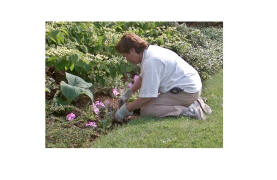 After
your soil is properly prepared
and the plants have been selected, it is time to get them
into the ground. Perhaps the single most important tip for
properly installing landscape ornamentals is to plant them
at the same depth at which they were growing at their
previous location. Nature has designed plants in such a
way to help them grow and function properly, survive and
multiply. There is a reason that the stem of a plant enters
the soil and becomes roots at a specific point. To the
extent that we can duplicate this relationship between soil
and the plant when we
transplant things, the greater our rate of success.
After
your soil is properly prepared
and the plants have been selected, it is time to get them
into the ground. Perhaps the single most important tip for
properly installing landscape ornamentals is to plant them
at the same depth at which they were growing at their
previous location. Nature has designed plants in such a
way to help them grow and function properly, survive and
multiply. There is a reason that the stem of a plant enters
the soil and becomes roots at a specific point. To the
extent that we can duplicate this relationship between soil
and the plant when we
transplant things, the greater our rate of success.
We will discuss the special case of
planting trees in
clay soils later but that is about the
only exception to this depth rule in the landscape. There are also
a few exceptions in the vegetable garden such as burying the
stems of tomato plants. This will encourage the development
of roots along the stem to build a stronger plant. However,
I don't know of any parallel situations in the ornamental landscape.
Before we start planting, it will be helpful to understand
the major challenges we face in having our plants survive
the process. We also need to recognize the various forms in
which plants are offered for sale in the nursery trade. The
type of nursery stock you purchase will help determine the
best techniques to use while transplanting things ranging
from trees to vines.
Finally, we will discuss some of the specifics for
installing various type of plants in the home landscape.



